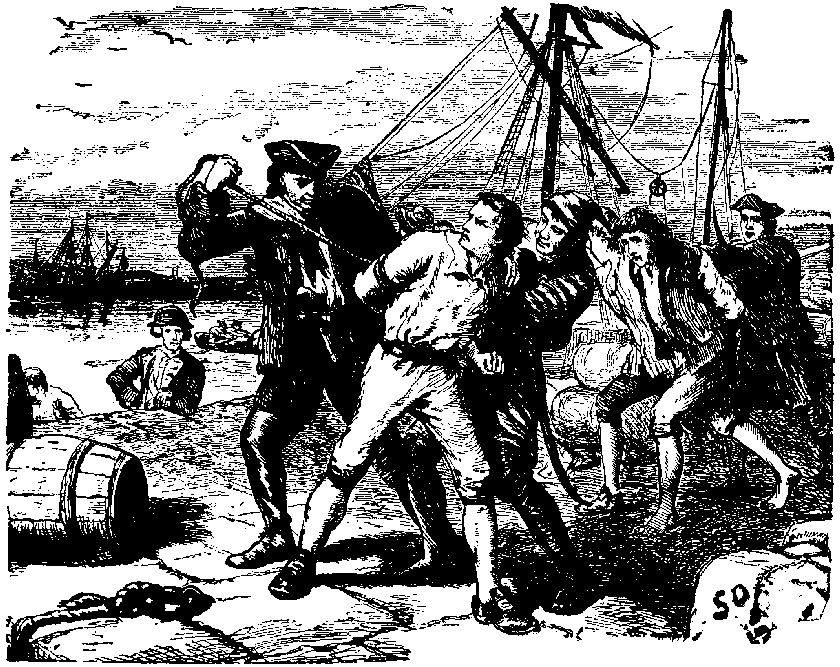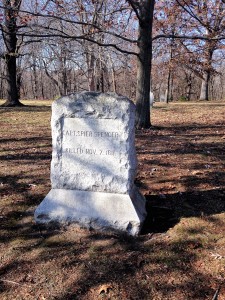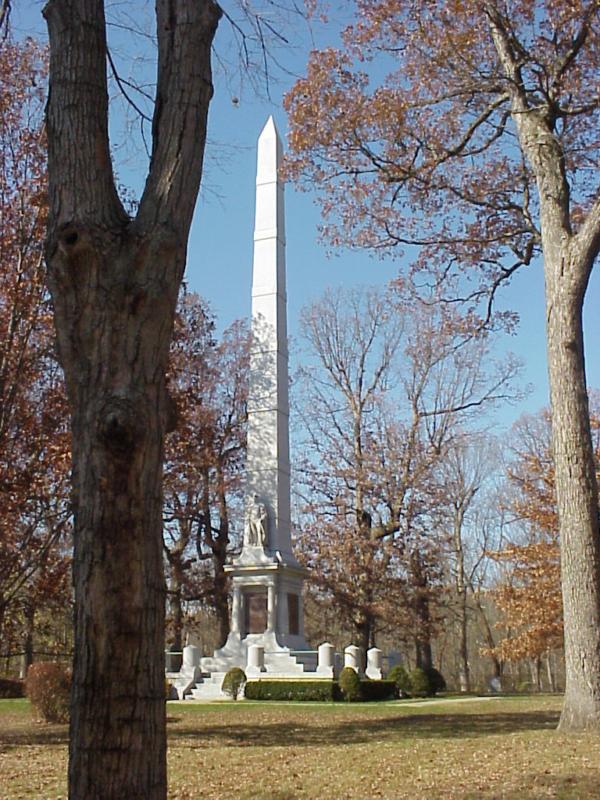
On November 6, 1811, warriors from Prophetstown, the headquarters for an Indian confederacy, led by Tenskwatawa, known as the Prophet, attacked US troops commanded by General Harrison near the Tippecanoe River. The battle lasted only two hours, resulting in heavy casualties on both sides. While largely indecisive, the battle helped sway the country to war with Britain in 1812. For the natives, the battle was the end of their dreams for a confederacy against the settlers, forcing them to join forces with the British as the only defense to their homeland.
The Road to Battle

Since winning the Revolutionary War, there had been little peace between the newly created United States and their former sovereign nation, Great Britain. Americans were angered by the British failure to abide by the Treaty of Paris as British troops continued to occupy American soil, such as their control of Fort Miami in the Ohio territory. The Indians were able to find support against the incoming American settlers from England as the British gave them weapons and other supplies. At sea, British ships began impressing, or as John Adams defined “kidnapping on the ocean,” American sailors [6, p. 127]. As the United States got involved in the Napoleonic War with the Non-Intercourse Act, which prohibited trade with Great Britain due to the continuation of American merchant ships seized by the British navy, many on the East Coast were angered by economic strain. When news of the HMS Leopard attack on the USS Chesapeake off the coast of Virginia broke out, many in New England began clamoring for war [7, p. 12]. This sparked outrage on the entire East Coast. The Pittsburgh Gazette declared the Leopard-Chesapeake crisis as, “the honor and independence of our nation insulted beyond the possibility of further forbearance” [6, p. 128]. For those on the coast, the incident was as critical as if the British had invaded Virginia.

In the west, the fear of foreign invasion came from the north. As tensions began to rise between Great Britain and the United States, Canadians made special efforts to secure Indian alliances with the use of gifts; in many cases this came in the form of weapons [7, p. 4]. This was ideal for the Indians because the Canadians were allies who would not invade their land, unlike the quarter million settlers moving across the Appalachian Mountains [7, p. 63]. With mass migration into the Ohio River Valley following the Revolutionary War, many tribes joined together in the Western Confederacy to counter this threat to their homeland. Under General Wayne, American troops put down the Confederacy with the victory at the Battle of Fallen Timbers in 1794, ending the Northwest Indian War. The Indians had received support and weapons from their British allies in Canada, which only fueled the rising tension between the American settlers and their northern neighbors [6, p. 67]. To the Americans, the Northwest Indian War was the result of British encouragement of Indian unrest against the incoming settlers in the Old Northwest Territory [7, p. 61]. Soon stories began to circulate about the Indians’ savage customs, such as scalping and human sacrifices on innocent and defenseless settlers by the barbaric natives. The tales engulfed the nation causing more and more Americans to want the Indian threat removed. One man from Kentucky even joined the Indiana militia out of “an abhorrence of those principles and practices of the savages, and their British allies” [6, p. 190]. As land treaties, such as the Treaty of Greenville (1795) and the Treaty of Grouseland (1805), became more commonplace, the natives witnessed most of their land transferred from local, tribal control to the United States government. The treaties also put the tribes living on that land under the United States protection, meaning all conflicts between individual native tribes as well as conflicts between settlers and Indians would be resolved through the American government [6, p. 90-91]. With a direct threat to their homeland, many chiefs were willing to put aside their traditional, separate ways of life when Tecumseh, chief of the Shawnee tribe and his brother, Tenskwatawa, also known as the Prophet, began preaching that unity was the only way to save their homes. The Prophet offered many of the younger generation an escape from the Westernization of their culture and a return to their old, traditional ways. Tecumseh, a man of military action, convinced warriors from different tribes that united they could push back the inflow of American settlers. Soon tribes began to assemble at Prophetstown in the Indiana territory as a new united Confederacy.
The Battle for the Indiana Territory

With rumors flooding Vincennes about Indians massing in Prophetstown, General Harrison gathered 1400 troops and in mid-September of 1811 began his long march to confront this renewed threat to the interior [4]. Accompanying the 1000 regulars were 400 men of the Indiana and Kentucky militias, including Captain Spencer and his brave Yellow Jackets of the Indiana militia. Rainy and cold conditions of a Midwest fall slowed the army’s progress. The troops marched with caution, always on the lookout for Indian ambushes. The closer the army came to their destination, the greater the chance of skirmishes between the two groups. However, this was not an imaginary fear; on the 2nd of November reports of boats being fired upon soon reached the troops [3, p. 179]. Additionally, learning that Tecumseh, the Indian chief who was responsible for the united Confederacy that threaten settlers, had traveled south to meet with other Indian chiefs leaving his brother in charge of around 600 warriors, Harrison quickened his troops and soon arrived on November 5 near the Tippecanoe River.

After holding a meeting with the Prophet in hopes of negotiating peace between the two groups, Harrison reported, “a mutual promise was again made for suspension of hostilities until we could have an interview on the following day” [2, p. 18]. However, not trusting the Indians sincerity for peace, he retired with orders for his troops to be prepared in case of the Prophet’s treachery [9]. Harrison doubted that the Prophet would keep the peace even before arriving at Prophetstown, as he told the regiments back in October “that we should have to fight the Indians” [3, p. 176]. The troops slept in uniforms and with their guns loaded next to them. Also, the troops set up camp in battle formation. It was done with a single rank which the Battle of Falling Timbers proved to be the most effective battle formation in Indian warfare [2, p. 18]. Even though Harrison took precautions, he only sent out a few patrols and left no sentries posted around camp. Additionally, fires were kept burning throughout the night due to the cold and rainy conditions of November. Some soldiers attested that the fires helped the Indians more than the army.

At 04:00, Harrison’s troop awoke to “the firing of guns and the Shawnies [Shawnees] braking into their tents” as the Prophet’s warriors attacked before daybreak [3, p. 180]. For two hours, Harrison’s troops struggled to overcome the Indians’ advances. The surprise even forced some troops to fight in their tents [5]. After the ensuing carnage, Harrison’s disciplined troops routed the outnumbered warriors driving them into the marshes “at the point of the bayonet,” winning the battle [2, p. 20]. It took bravery and heroism to overcome the aggressors. As one soldier, John Tipton who fought under Captain Spencer, reported, “they kept up a firing on three sides of us took our tent from the gueard [guard] fire. Our men fought Brave and By the timely help of Capt. Cook with a Company of infantry we maid [made] a Charge and Drove them out of the timber across the prairie” [3, p. 181]. Harrison’s strategy during the fighting was to keep the lines intact until daylight. By moving Captain Cook’s company of riflemen to reinforce Captain Spencer, Harrison prevented the Indian warriors from breaking the troop’s lines and entering the camp. He attested that while “the Indians manifested a ferocity, uncommon even with them,” they could not overcome his “troops who opposed their savage fury with that cool and deliberate valor which is characteristic of the Christian soldier” [2, p. 21]. The next day the company ventured to Prophetstown where they found it deserted. After burning the town to ashes and seizing most of the grain stores, Harrison retreated with his weary troops back to Vincennes due to lack of ammunition and supplies as well as rumors reaching him of the return of Tecumseh with the main force of the Confederacy [6, p. 130].
The Aftermath and Road to War

While considered by most to be an American victory, the Battle of Tippecanoe was largely indecisive. The surprise attack left 37 dead, an additional 25 died from injuries, and another 126 wounded for Harrison, and an estimated 40 dead and 60 wounded for the Prophet [4]. For the Yellow Jackets, they lost their Captain, First Lieutenant McMahan, Captain Berry as well as five others [3, p. 181]. The battle pushed many tribes into aligning themselves with Tecumseh and the Prophet after what they saw as an unprovoked attack by the United States army on an Indian settlement. Additionally, out of the ashes, Prophetstown was rebuilt a month after Harrison left [6, p. 313]. However, while Tecumseh would remain a threat until his death in the ensuing war, the fear of a grand Indian Confederacy was eliminated. The battle also enabled pioneers to safely settle the Indiana frontier as tribes were forced farther west, and in five years the Indiana territory would enter the Union as the 19th state of America [8]. The Battle of Tippecanoe saw the American frontier pushed farther west much to the dismay of the Indians.
The Battle of Tippecanoe was the spark that ignited the fuse that led to the War of 1812. Many Americans saw the Confederacy as a tool for Great Britain to terrorize the Northwest territories, including Harrison, who said, “I really fear that this Prophet is an Engine set to work by the British for some bad purpose” [6, p. 128]. Following the end of his dreams for a united Indian force against the tide of invading settlers, Tecumseh allied himself with the British forces in Canada. This only fueled the war hysteria that soon engulfed the nation. As one newspaper wrote after learning of the battle, “Again from various circumstances, such as the conferences of Indians with our good friends the British, and the intrigues which the British have uniformly had with them whenever any hostile attitude was taken by the government towards us, together with other facts- we have believed that war would ensure” [1, p. 240]. The War Hawks of New England joined the westerners anger of British support of Indians with their own fury of economic loss caused by Great Britain on the high seas. After the battle, the anti-British attitude would dominate Washington. On June 12, 1812, less than a year after Harrison burned down Prophetstown, the United States declared war on Great Britain.

Primary Sources:
- Dooley, Patricia L. “The Battle of Tippecanoe, November 7-8, 1811.” The Early Republic: Primary Documents on Events from 1799 to 1820. Westport, CT: Greenwood, 2004. 240-41.
- Durfee, David A. William Henry Harrison 1773-1841: John Tyler 1790-1862: Chronology, Documents, Bibliographical Aids. Dobbs Ferry, NY: Oceana Publ., 1970.
- Tipton, John, John Tipton’s Tippecanoe Journal. Indiana Magazine of History. December, 1906: 170-184.
Secondary Sources:
- Hickman, Kennedy. “Tecumseh’s War: Battle of Tippecanoe.” About.com Education. N.p., 09 Mar. 2015.
- Tippecanoe County Historical Association. “History of the Battle of Tippecanoe.” Battle of Tippecanoe History. Tippecanoe County Historical Association, n.d.
- Jortner, Adam Joseph. The Gods of Prophetstown: The Battle of Tippecanoe and the Holy War for the American Frontier. Oxford: Oxford UP, 2012.
- Mason, Philip P. After Tippecanoe: Some Aspects of the War of 1812. East Lansing: Michigan State UP, 1963.
- Trice, Nancy. “Chapter VII Effect of the Battle.” The Battle of Tippecanoe. USGENWEB, n.d.
- U.S. Army Center of Military History. “Battle of Tippecanoe, 1811.” U.S. Army Center Of Military History. U.S. ARMY CENTER OF MILITARY HISTORY, 24 Nov. 2014.
Further Reading
- “Battle of Tippecanoe.” Wikipedia. Wikimedia Foundation, n.d. Web. 15 Oct. 2016.
